Search results for "pican"
-

SK Pang Electronics PiCAN 2 Duo (CAN-Bus Board for Raspberry Pi 4 with 3 A SMPS)
This PiCAN2 Duo board provides two independent CAN-Bus channels for the Raspberry Pi 4. It uses the Microchip MCP2515 CAN controller with MCP2551 CAN transceiver. Connections are made via 4-way screw terminal. This board has a 5 V/3 A SMPS that can power the Raspberry Pi is well via the screw terminal.p Easy to install SocketCAN driver. Programming can be done in C or Python. Features CAN v2.0B at 1 Mb/s High speed SPI Interface (10 MHz) Standard and extended data and remote frames CAN connection screw terminal 120 Ω terminator ready Serial LCD ready LED indicator Four fixing holes, comply with Pi Hat standard SocketCAN driver, appears as can0 and can1 to application Interrupt RX on GPIO25 and GPIO24 5 V/3 A SMPS to power Raspberry Pi and accessories from screw terminal Reverse polarity protection High efficiency switch mode design 7-24 V input range Downloads User guide Schematic Rev D Writing your own program in Python Python3 examples in Github
€ 99,95€ 84,95
Members identical
-
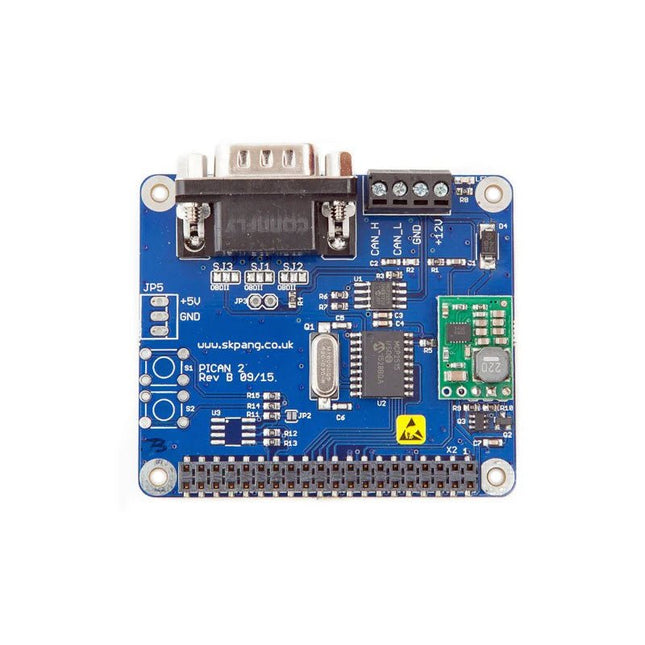
SK Pang Electronics PiCAN 2 (CAN-Bus Board for Raspberry Pi 2/3 with SMPS)
This PiCAN 2 board provides CAN-Bus capability for the Raspberry Pi 2/3. It uses the Microchip MCP2515 CAN controller with MCP2551 CAN transceiver. Connection are made via DB9 or 3-way screw terminal. This board includes a switch mode power suppler that powers the Raspberry Pi is well. Easy to install SocketCAN driver. Programming can be done in C or Python. Not suitable for Raspberry Pi 4, please use PiCAN 3 instead. Features CAN v2.0B at 1 Mb/s High speed SPI Interface (10 MHz) Standard and extended data and remote frames CAN connection via standard 9-way sub-D connector or screw terminal Compatible with OBDII cable Solder bridge to set different configuration for DB9 connector 120Ω terminator ready Serial LCD ready LED indicator Foot print for two mini push buttons Four fixing holes, comply with Pi Hat standard SocketCAN driver, appears as can0 to application Interrupt RX on GPIO25 5 V/1 A SMPS to power Raspberry Pi and accessories from DB9 or screw terminal Reverse polarity protection High efficiency switch mode design 6-20 V input range Optional fixing screws – select at bottom of this webpage Downloads User guide Schematic Rev B Writing your own program in Python Python3 examples in Github
€ 59,95
Members € 53,96
-
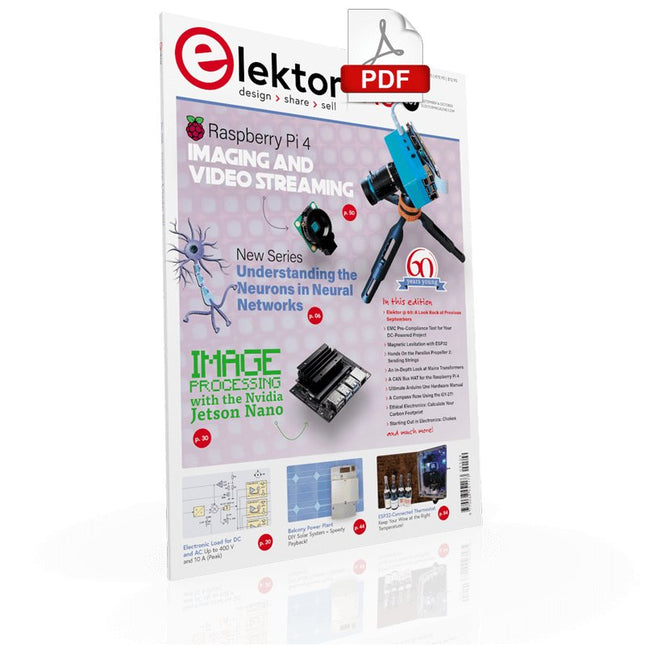
Elektor Digital Elektor September/October 2021 (PDF)
UNDERSTANDING THE NEURONS IN NEURAL NETWORKS (PART 1)Artificial Neurons EMC PRE-COMPLIANCE TEST FOR YOUR DC-POWERED PROJECT (PART 1)Dual DC LISN ELECTRONIC LOAD FOR DC AND ACUp to 400 V and 10 A (Peak) STARTING OUT IN ELECTRONICSEasier Than Imagined! ...Taking on the Choke! IMAGE PROCESSING WITH THE NVIDIA JETSON NANO (PART 1)The Hardware and Software AN IN-DEPTH LOOK AT MAINS TRANSFORMERSHow Do They Behave When They Are Switched On and Off? YES WE CAN WITH PICAN 3A CAN Bus HAT for the Raspberry Pi 4 BALCONY POWER PLANTDIY Solar Balcony = Speedy Payback! IMAGING AND VIDEO-STREAMING WITH A RASPBERRY PI 4The Raspberry Pi High-Quality Camera in Practice USING DISPLAYS IN RASPBERRY PI PROJECTSSample Chapter: Organic Light Emitting Diode Displays (OLED) HANDS ON THE PARALLAX PROPELLER 2 (PART 4)Sending Strings ELEKTOR @ 60A Look Back at Previous Septembers HOMELAB TOURSIn the Friesian Countryside, Where the Tubes Bloom ... HYBRIDSPeculiar Parts, the series A COMPASS ROSE USING THE GY-271Or Why We Move in Figures of Eight to Calibrate a Sensor FINDING YOUR FOOTPRINTCalculate the Carbon Footprint of Your Electronics ESP32-CONNECTED THERMOSTATKeep Your Wine at the Right Temperature! MAGNETIC LEVITATION THE DIGITAL WAYESP32 Pico Replaces the Analog Comparator ULTIMATE ARDUINO UNO HARDWARE MANUALSample Chapter: Main Microcontroller Bootloader MICROPYTHON FOR THE ESP32 AND FRIENDS (PART 2)Control Matrix Displays Easily MADMACHINE SWIFTIO BOARDModern Language Meets Modern Hardware FROM LIFE’S EXPERIENCEOn-Again, Off-Again Relationship HEXADOKUThe Original Elektorized Sudoku
€ 7,50
-

Pimoroni Picade X HAT USB-C
Turn your Raspberry Pi into a retro games console! Picade X HAT includes joystick and button inputs, a 3 W I²S DAC/amplifier, and soft power switch. This HAT has all the same great features as the original Picade HAT but now has no-fuss female Dupont connectors to hook up your joystick and buttons. Simply pop Picade X HAT onto your Pi, plug a USB-C power supply into the connector on the HAT (it back-powers your Pi through the GPIO, so no need for a separate power supply), wire up your controls, and install the driver! It's ideal for your own DIY arcade cabinet builds, or for interfaces that need big, colourful buttons and sound. Features I²S audio DAC with 3 W amplifier (mono) and push-fit terminals Safe power on/off system with tactile power button and LED USB-C connector for power (back-powers your Pi) 4-way digital joystick inputs 6x player button inputs 4x utility button inputs 1x soft power switch input 1x power LED output Plasma button connector Breakout pins for power, I²C, and 2 additional buttons Picade X HAT pinout Compatible with all 40-pin Raspberry Pi models The I²S DAC blends both channels of digital audio from the Raspberry Pi into a single mono output. This is then passed through a 3 W amplifier to power a connected speaker. The board also features a soft power switch that allows you turn your Pi on and off safely without risk of SD card corruption. Tap the connected button to start up, and press and hold it for 3 seconds to fully shutdown and disconnect power. Software/Installation Open a terminal and type curl https://get.pimoroni.com/picadehat | bash to run the installer. You'll need to reboot once the installation is complete, if it doesn't prompt you to do so. The software does not support Raspbian Wheezy Notes With USB-C power connected through Picade X HAT you'll need either to tap the connected power button or the button marked 'switch' on the HAT to power on your Pi.
€ 24,95
Members € 22,46
-

Elektor Digital PIC Cookbook for Virtual Instrumentation (E-book)
The software simulation of gauges, control-knobs, meters and indicators which behave just like real hardware components on a PC’s screen is known as virtual instrumentation. In this book, the Delphi program is used to create these mimics and PIC based external sensors are connected via a USB/RS232 converter communication link to a PC. Detailed case studies in this Book include a virtual compass displayed on the PC’s screen, a virtual digital storage oscilloscope, virtual -50 to +125 degree C thermometer, and FFT sound analyser, a joystick mouse and many examples detailing virtual instrumentation Delphi components. Arizona’s embedded microcontrollers – the PIC's are used in the projects and include PIC16F84A, PIC16C71, DSPIC30F6012A, PIC16F877, PIC12F629 and the PIC16F887. Much use is made of Microchip’s 44 pin development board (a virtual instrument ‘engine)’, equipped with a PIC16F887 with an onboard potentiometer in conjunction with the PIC’s ADC to simulate the generation of a variable voltage from a sensor/transducer, a UART to enable PC RS232 communications and a bank of 8 LED's to monitor received data is also equipped with an ISP connector to which the ‘PICKIT 2’ programmer may easily be connected. Full source code examples are provided both for several different PIC’s, both in assembler and C, together with the Pascal code for the Delphi programs which use different 3rd party Delphi virtual components.
€ 19,95
Members € 15,96
-
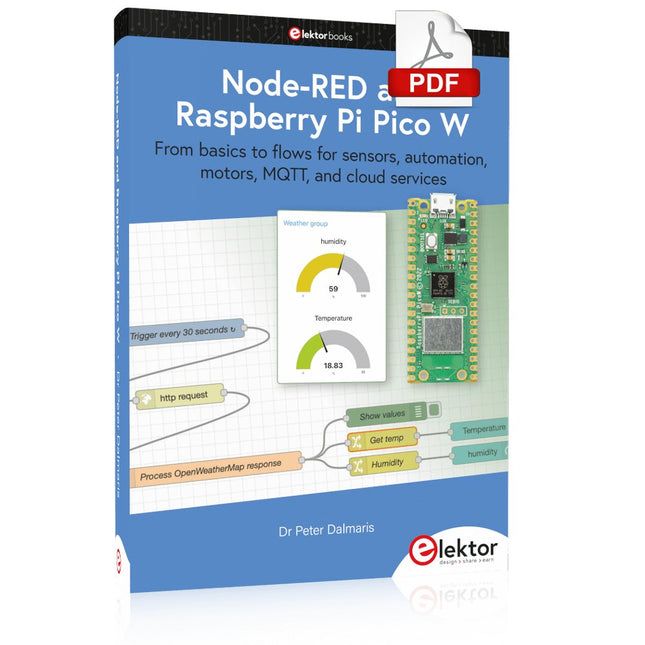
Elektor Digital Node-RED and Raspberry Pi Pico W (E-book)
From basics to flows for sensors, automation, motors, MQTT, and cloud services This book is a learning guide and a reference. Use it to learn Node-RED, Raspberry Pi Pico W, and MicroPython, and add these state-of-the-art tools to your technology toolkit. It will introduce you to virtual machines, Docker, and MySQL in support of IoT projects based on Node-RED and the Raspberry Pi Pico W. This book combines several elements into a platform that powers the development of modern Internet of Things applications. These elements are a flow-based server, a WiFi-enabled microcontroller, a high-level programming language, and a deployment technology. Combining these elements gives you the tools you need to create automation systems at any scale. From home automation to industrial automation, this book will help you get started. Node-RED is an open-source flow-based development tool that makes it easy to wire together devices, APIs, and online services. Drag and drop nodes to create a flowchart that turns on your lights at sunset or sends you an email when a sensor detects movement. Raspberry Pi Pico W is a version of the Raspberry Pi Pico with added 802.11n Wi-Fi capability. It is an ideal device for physical computing tasks and an excellent match to the Node-RED. Quick book facts Project-based learning approach. Assumes no prior knowledge of flow-based programming tools. Learn to use essential infrastructure tools in your projects, such as virtual machines, Docker, MySQL and useful web APIs such as Google Sheets and OpenWeatherMap. Dozens of mini-projects supported by photographs, wiring schematics, and source code. Get these from the book GitHub repository. Step-by-step instructions on everything. All experiments are based on the Raspberry Pi Pico W. A Wi-Fi network is required for all projects. Hardware (including the Raspberry Pi Pico W) is available as a kit. Downloads GitHub
€ 39,95
Members € 31,96
-
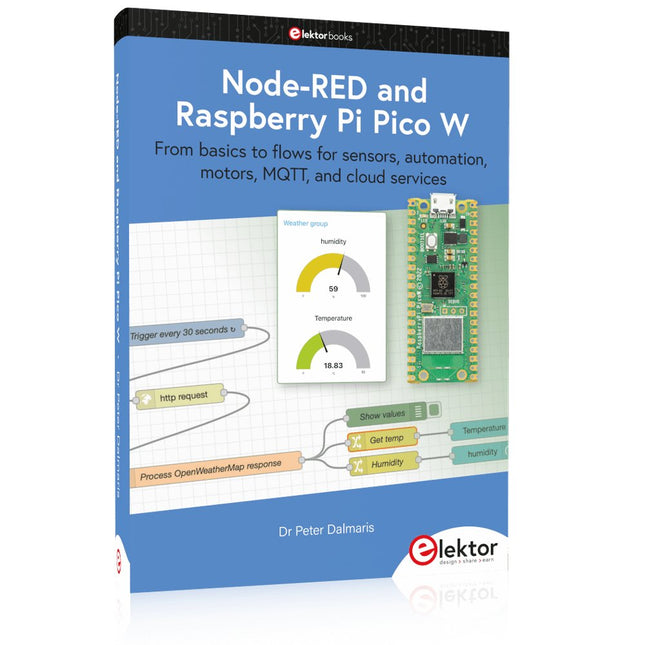
Elektor Publishing Node-RED and Raspberry Pi Pico W
From basics to flows for sensors, automation, motors, MQTT, and cloud services This book is a learning guide and a reference. Use it to learn Node-RED, Raspberry Pi Pico W, and MicroPython, and add these state-of-the-art tools to your technology toolkit. It will introduce you to virtual machines, Docker, and MySQL in support of IoT projects based on Node-RED and the Raspberry Pi Pico W. This book combines several elements into a platform that powers the development of modern Internet of Things applications. These elements are a flow-based server, a WiFi-enabled microcontroller, a high-level programming language, and a deployment technology. Combining these elements gives you the tools you need to create automation systems at any scale. From home automation to industrial automation, this book will help you get started. Node-RED is an open-source flow-based development tool that makes it easy to wire together devices, APIs, and online services. Drag and drop nodes to create a flowchart that turns on your lights at sunset or sends you an email when a sensor detects movement. Raspberry Pi Pico W is a version of the Raspberry Pi Pico with added 802.11n Wi-Fi capability. It is an ideal device for physical computing tasks and an excellent match to the Node-RED. Quick book facts Project-based learning approach. Assumes no prior knowledge of flow-based programming tools. Learn to use essential infrastructure tools in your projects, such as virtual machines, Docker, MySQL and useful web APIs such as Google Sheets and OpenWeatherMap. Dozens of mini-projects supported by photographs, wiring schematics, and source code. Get these from the book GitHub repository. Step-by-step instructions on everything. All experiments are based on the Raspberry Pi Pico W. A Wi-Fi network is required for all projects. Hardware (including the Raspberry Pi Pico W) is available as a kit. Downloads GitHub
€ 49,95
Members € 44,96
-
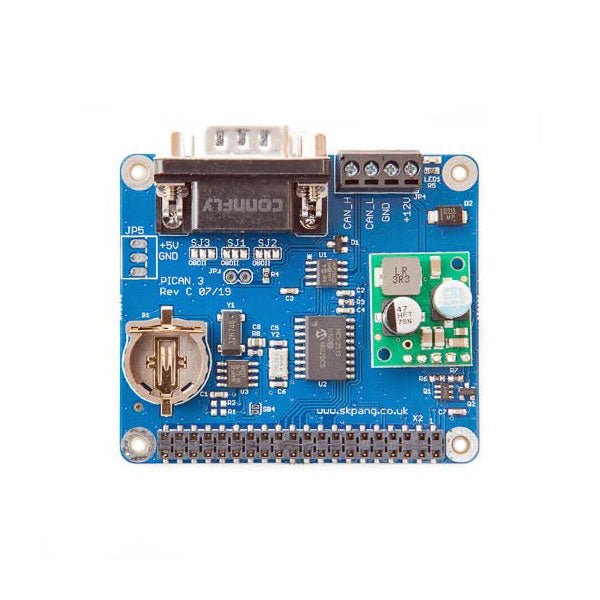
SK Pang Electronics PiCAN 3 (CAN-Bus Board for Raspberry Pi 4 with 3 A SMPS & RTC)
This PiCAN3 board provides CAN-Bus capability for the Raspberry Pi 4. It uses the Microchip MCP2515 CAN controller with MCP2551 CAN transceiver. Connection are made via DB9 or 3-way screw terminal. This board includes a switch mode power suppler that powers the Raspberry Pi is well. Easy to install SocketCAN driver. Programming can be done in C or Python. Features CAN v2.0B at 1 Mb/s High speed SPI Interface (10 MHz) Standard and extended data and remote frames CAN connection via standard 9-way sub-D connector or screw terminal Compatible with OBDII cable Solder bridge to set different configuration for DB9 connector 120Ω terminator ready Serial LCD ready LED indicator Four fixing holes, comply with Pi Hat standard SocketCAN driver, appears as can0 to application Interrupt RX on GPIO25 5 V/3 A SMPS to power Raspberry Pi and accessories from DB9 or screw terminal Reverse polarity protection High efficiency switch mode design 6-24 V input range Optional fixing screws – select at bottom of this webpage RTC with battery backup (battery not included, requires CR1225 cell) Downloads User guide Schematic Driver installation Writing your own program in Python Python3 examples
-

SK Pang Electronics PiCAN-M with CAN-Bus Micro-C and RS422 Connector + 3 A SMPS
This is a PiCAN-M with RS422 and Micro-C connector. The RS422 is via a 5-way screw terminal. The CAN-Bus connection is via Micro-C connector. This board includes a 3 A SMPS. The 12 V is from the Micro-C network can be use to power the PiCAN-M and the Raspberry Pi. Features CAN connection via Micro-C connector 120 Ω terminator ready SocketCAN driver Appears as can0 to application RS422 via 5-way screw terminal appears as ttyS0 to application LED indicator (GPIO22) Qwiic (I²C) connector for extra sensors Include 3 A SMPS to power the board and the Raspberry Pi from 12 V line Compatible with OpenCPN, OpenPlotter, Signal K and CANBoat Downloads Schematic User Guide for OpenPlotter v3 User Guide for OpenPlotter v2
-
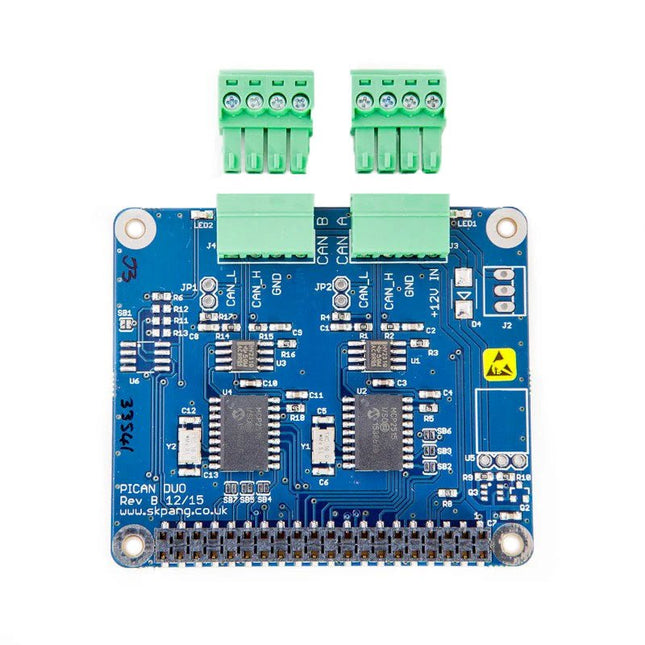
SK Pang Electronics PiCAN 2 Duo (CAN-Bus Board for Raspberry Pi)
The PiCAN2 Duo board provides two independent CAN-Bus channels for the Raspberry Pi 2, 3, and 4. It uses the Microchip MCP2515 CAN controller, with connections made via a 4-way screw terminal. An easy-to-install SocketCAN driver is available, and programming can be done in C or Python. Features CAN v2.0B at 1 Mb/s High speed SPI Interface (10 MHz) Standard and extended data and remote frames CAN connection screw terminal 120Ω terminator ready Serial LCD ready LED indicator Four fixing holes, comply with Pi Hat standard SocketCAN driver, appears as can0 and can1 to application Interrupt RX on GPIO25 and GPIO24 Downloads User guide Schematic Rev B Software installation Writing your own program in Python









